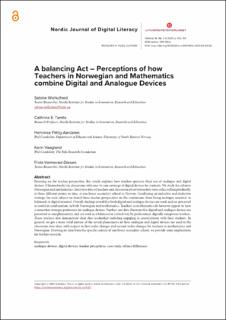A balancing Act – Perceptions of how Teachers in Norwegian and Mathematics combine Digital and Analogue Devices
Wollscheid, Sabine; Tømte, Cathrine Edelhard; Flittig-Aardalen, Henrikke; Vaagland, Karin; Vennerød-Diesen, Frida Felicia
Peer reviewed, Journal article
Published version
Permanent lenke
https://hdl.handle.net/11250/2839475Utgivelsesdato
2021Metadata
Vis full innførselSamlinger
- Institutt for pedagogikk [295]
- Publikasjoner fra CRIStin [3781]
Originalversjon
Wollscheid, S., Tømte Cathrine, E., Flittig-Aardalen, H., Vaagland, K. & Vennerød-Diesen, F. A balancing Act – Perceptions of how Teachers in Norwegian and Mathematics combine Digital and Analogue Devices. Nordic Journal of Digital Literacy, 16(3-4), 102-114. https://doi.org/10.18261/issn.1891-943x-2021-03-04-02Sammendrag
Focusing on the teacher perspective, this article explores how teachers perceive their use of analogue and digital devices (Chromebooks) in classrooms with one-to-one coverage of digital devices for students. We study the subjects Norwegian and mathematics. Interview data of teachers and classroom observation data were collected longitudinally, at three different points in time, at one lower secondary school in Norway. Combining an inductive and deductive strategy, for each subject we found three teacher perspectives on the continuum, from being analogue oriented, to balanced, to digital oriented. Overall, findings reveal that both digital and analogue devices are used, and are perceived as useful in combination, in both Norwegian and mathematics. Teachers in mathematics do however appear to have a somewhat stronger preference for analogue devices. Further, our data illustrate that digital and analogue devices are perceived as complementary, and are used in a balanced or critical way by professional, digitally competent teachers. These teachers also demonstrate clear class leadership including engaging in conversations with their students. In general, we get a more valid picture of the actual phenomena on how analogue and digital devices are used in the classroom over time, with respect to first-order changes and second-order changes for teachers in mathematics and Norwegian. Drawing on data from the specific context of one lower secondary school, we provide some implications for further research.

